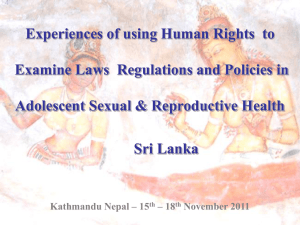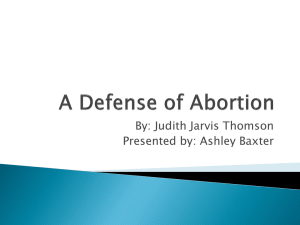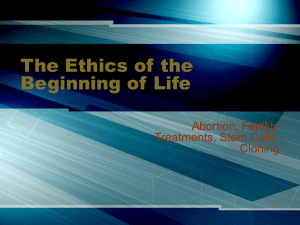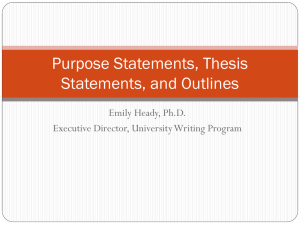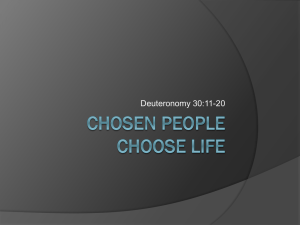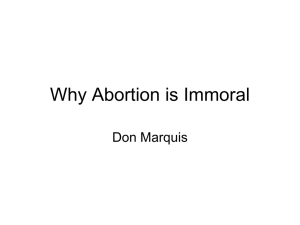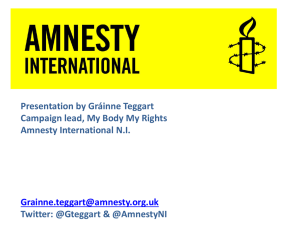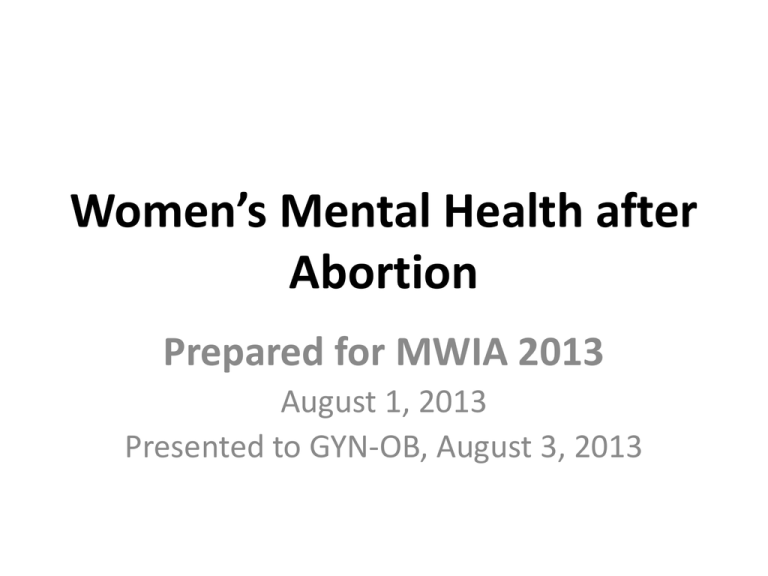
Women’s Mental Health after
Abortion
Prepared for MWIA 2013
August 1, 2013
Presented to GYN-OB, August 3, 2013
Dr. Martha Shuping, M.D.
martha.shuping@gmail.com
Psychiatrist
Disclosures
• As an undergraduate student, I worked as a
volunteer abortion counselor at a clinic that
helped women to obtain abortions.
• I have done volunteer work for both prochoice and pro-life NGO’s.
• There are no financial conflicts regarding this
presentation.
Researchers on both sides agree:
Researchers on both sides of the abortion issue
agree that there are specific subgroups of
women who are at increased risk for mental
health problems after abortion.
APA 2008 Report
• Identified at least 17 risk factors, indicating
subgroups of women at increased risk for
problems after abortion, due to pre-existing
characteristics of the women or their social
situation.
Two Case Reports: Melody & Donna
Today’s presentation will focus on two case
reports of women who experienced mental
health problems after abortion and examine
relevant risk factors pertaining to these cases.
Case Report: Melody
• Married, mother of two children.
• Financially secure; able to stay home with
children.
• No prior psychiatric history.
• Pregnant for third time.
• Pregnancy was wanted and meaningful to her.
• Husband said to terminate—he did not have
the energy for one more child.
Case Report: Melody
• Minister of their church said Melody should
honor husband’s wishes.
• Melody terminated the pregnancy.
• But she believed she had committed the
unforgiveable sin.
• She felt unable to pray, which has always been
important to her.
• She was unable to function in her roles as
mother, homemaker, and wife.
Case Report: Melody
• Major Depressive Episode.
• Suicidal.
• Hospitalized and given antidepressant
medication.
• Helped by “peer counselor” to resolve
problems she experienced regarding conflict
with her personal and religious beliefs.
• Episode resolved.
Case Report: Donna
•
•
•
•
•
•
17 years old.
Engaged to be married.
Fiancee away due to job training.
Pregnant & happy about pregnancy.
Pregnancy was wanted and meaningful to her.
Concealed the pregnancy from mother.
Case Report: Donna
Mother:
• Discovered the pregnancy.
• Said: “You can’t live at home and have the baby.”
• Wanted to keep the pregnancy a secret due to
mother’s shame; did not want others to find out
about the pregnancy.
• Wanted Donna to have an abortion.
• Made appointment at the abortion clinic.
Case Report: Donna
Donna:
• senior in high school with no job and no
money.
• had religious beliefs against abortion.
• expressed commitment to the pregnancy.
• sought help from pro-life pregnancy resource
center to live away from mother’s home, but
housing could not be found in time.
Case Report: Donna
• Mother took Donna to clinic.
• Donna intended to refuse the abortion.
• Donna told the doctor and the nurse: “I do not
consent to this abortion; I want my baby.”
• Donna was sedated and restrained and the
pregnancy was terminated without her
consent.
• This was a second trimester abortion.
Case Report: Donna
• Forced abortion took place in the
mistaken belief that because Donna was
not of legal age, she did not have the
right to make her own choice.
• But, in the U.S., in all 50 states, it is illegal
to force anyone to have an abortion
against their wishes, even young women
in their teens.
Case Report: Donna
For 12 years after the abortion, Donna
experienced panic attacks associated with:
• Tachycardia
• Chest pain
• Nausea
• Vomiting
• Diarrhea
• Feelings of panic
Case Report: Donna
The panic episodes were very disruptive to her
life and frequently:
• prevented her from working.
• prevented her from keeping appointments for
social activities.
• caused her to go to the hospital Emergency
Dept. many times because she thought she
may be having heart attack.
Case Report: Donna
Depressive symptoms included:
• Depressed & irritable mood.
• Frequent crying spells.
• Lack of interest & lack of enjoyment.
• Excessive guilt.
• Concentration problems.
• Low energy.
Donna’s PTSD symptoms
• Feeling alienated from others (e.g.,
detachment or estrangement).
-She married her fiancee but the marriage
ended in divorce.
-She had problems bonding with her
children, with father given custody of
children.
-She was estranged from her mother for 12
years.
Donna’s PTSD symptoms
• Intense distress after exposure to traumatic
reminders.
- When she saw television advertisements
in which pro-choice views were expressed, she
became very distressed and had crying spells.
She said, “It wasn’t a choice for me.”
Donna’s PTSD symptoms
Avoidance of Trauma-related external
reminders:
- She avoided driving on the street where
the abortion clinic was located, and would go
out of her way to avoid driving past the clinic.
Donna’s PTSD symptoms
• Persistent negative trauma-related emotions
(e.g., fear, anger, guilt, shame).
• Markedly diminished interest in
(pretraumatic) significant activities.
• Irritable Behavior
• Concentration problems
Donna: Resolution
• Treated with sertraline (antidepressant
medication) with only partial benefit.
• Invested much time and energy in useless
cardiac evaluations because panic symptoms
caused her think she was having cardiac
problems.
• Attended a faith-based abortion recovery
weekend with resolution of symptoms
afterward.
Donna: Resolution
• Started course of study at technical college
and trained for career she now enjoys.
• After one year moved out of area but was
doing well at last contact.
1999
A Clinician’s Guide to
Medical & Surgical Abortion
• This is a textbook to teach medical doctors
how to perform abortions.
• It is written by abortion providers for abortion
providers.
• This book lists 13 risk factors for mental
health problems after abortion, identifying
subgroups of women who are at increased risk
for problems after abortion.
A Clinician’s Guide, Chapter 3
Baker A, Beresford T, Halvorson-Boyd G, Garrity
JM. Chapter 3, Informed consent, counseling,
and patient preparation. In: Paul M, Lichtenberg
ES, Borgatta L, Grimes DA, and Stubblefield PG,
eds. A Clinician’s Guide to Medical and Surgical
Abortion. Philadelphia, PA: Churchill Livingston;
1999:28-29.
2009
Management of unintended and abnormal
pregnancy: Comprehensive Abortion Care
Maureen Paul, E. Steve Lichtenberg,
Lynn Borgatta, David A. Grimes,
Phillip G. Stubblefield, Mitchell D. Creinin
• This textbook now lists 18 risk factors for
mental health problems after abortion.
• Note: on the cover of this book is the logo of
the National Abortion Federation
• Baker A, Beresford T. Chapter 5, Informed
consent, patient education and counseling. In:
Paul M, Lichtenberg ES, Borgatta L, Grimes DA,
Stubblefield PG, Creinin MD, eds.
Management of Unintended and Abnormal
Pregnancy. Chichester, UK: Wiley-Blackwell.
2009:51.
APA Report, 2008
American Psychological Association Task Force
on Mental Health and Abortion. Report of the
Task Force on Mental Health and Abortion.
Washington, DC. American Psychological
Association; 2008.
• www.apa/org/pi/wpo/mental-healthabortion-report.pdf
APA Report, 2008
Identified at least 17 risk factors, indicating
subgroups of women at increased risk for
problems after abortion, due to pre-existing
characteristics of the women or their social
situation.
Risk Factors that apply to
Donna and/or Melody
We will now review the particular risk factors
from these two textbooks and other sources
that specifically apply to Donna and/or Melody.
Researchers from Both Sides Agree:
• Women who are committed to the pregnancy
or who prefer to carry the child to term are at
risk for mental health problems after
abortion.
• Clinician’s Guide (1999).
• Comprehensive Abortion Care (2009).
• At least 7 studies to date.
• APA 2008 report.
Clinician’s Guide, 1999
“Commitment to the pregnancy” is listed as a
risk factor for problems after abortion.”
Comprehensive Abortion Care, 2009
“Commitment and attachment to the
pregnancy” is listed as a risk factor for negative
emotional reactions after abortion.
Researchers from Both Sides Agree:
Women who are coerced or pressured are at
increased risk for mental health problems after
abortion.
• Clinician’s Guide & Comprehensive Abortion
Care
• At least 13 studies to date
• APA 2008 Report
• Council on Scientific Affairs of the AMA
• Council on Scientific Affairs, American Medical
Association, “Induced Termination of
Pregnancy Before and After Roe v Wade:
Trends in Mortality and Morbidity of Women,”
JAMA, 268(22):3231-3239 (1992).
Researchers on Both Sides Agree:
Lack of emotional / social support and receiving
criticism from significant people in their lives is a
risk factor for mental health problems after
abortion.
• Clinician’s Guide (1999)
• Comprehensive Abortion Care (2009)
• APA 2008 Report
• At least 20 studies to date
Researchers on Both Sides Agree:
Advanced stage of pregnancy (late term
abortion, after first trimester) is a risk factor for
negative emotional sequelae” after abortion.
• Comprehensive Abortion Care (2009)
• APA 2008 Report
Researchers on Both Sides Agree:
Perceived need for secrecy is a risk factor for
mental health problems after abortion.
• Comprehensive Abortion Care (2009)
• APA 2008 Report
Researchers on Both Sides Agree:
Adolescence is a risk factor for increased mental
health problems after abortion.
• APA 2008 Report
• Planned Parenthood 1993 Fact Sheet
• Multiple studies indicating adolescence as a
risk factor, some including young adults or
“young women.”
Recap of APA 2008, Risk Factors
that apply to Donna and Melody
1. Terminating a pregnancy that is wanted or
meaningful.
2. Feelings of commitment to the pregnancy
3. Perceived pressure from others to terminate
a pregnancy.
APA 2008, Risk Factors
Applying to Donna
• 4. Lack of perceived social support from
others
• 5. Perceived need for secrecy
• 6. Feelings of commitment to the pregnancy
• 7. Late term (other than 1st trimester)
abortion
• 8. Being an adolescent (not an adult)
Religious Beliefs as Risk Factor
Having strong religious convictions against
abortion, or believing that one is acting against
one’s own values, is a risk factor.
• Planned Parenthood 1993 Fact Sheet
• At least 10 studies to date.
Pre-abortion screening & counseling
• Comprehensive Abortion Care (2009) has an
example of a “needs assessment” form that
asks many questions that are based on some
of the known risk factors we have discussed,
and other risk factors identified in the above
sources. (Time does not permit discussion of
all risk factors today).
Pre-abortion screening & counseling
If Melody or Donna had completed this form at
the clinic prior to their abortions, they would
have answered questions about:
• Their beliefs about abortion and their religious
beliefs
• Who is pressuring them
• Do they want the baby instead of abortion
• Discussion of these risk factors with Donna
(and possibly with her mother) and with
Melody (and possibly with her husband) could
have led to more accurate consideration of
the applicable specific risks applicable to their
situation, and may have led to a different
decision for these women.
Prenatal Bonding
• Comprehensive Abortion Care (2009) stated
that the commitment to the pregnancy and
attachment to the pregnancy were risk
factors. This refers to prenatal bonding that
many women experience.
Prenatal Bonding
• Australian researchers Allanson & Astbury
(1996) revealed that a significant number of
women attending an abortion clinic reported
having fantasies about the child and engaging
in attachment behaviors.
• 40% talked to their fetus
• 30% rubbed their stomach
Prenatal Bonding
• Published studies for more than 60 years have
consistently
concluded that attachment or
“
bonding between mother and child begins
during pregnancy, not at birth.
• Several authors have demonstrated that the
the degree of bonding that is established
during pregnancy is predictive of the degree
of emotional distress and trauma symptoms
that are experienced after the abortion.
Qualitative Study:
Women’s Views at Menopause
• Long term follow-up of emotional experiences
after termination of pregnancy: women’s views at
menopause, by Kathryn Dykes, et al.
• Journal of Reproductive and Infant Psychology
2010, 1–20, iFirst Article
• ISSN 0264-6838 print/ISSN 1469-672X online ©
2010 Society for Reproductive and Infant
Psychology DOI: 10.1080/02646838.2010.513046
http://www.informaworld.com
Women’s Views at Menopause,
Looking Back at Past Abortion
• All women reported that they continued to think about the child
they had aborted many years previously, expressing long lasting
attachment to the child lost to abortion: Examples:
• Jenny said, “I’ve always thought of him … wondering how old he’d
be, I do wonder about that child.”
• Elaine also thought about the baby and remembered the expected
due date each year, thinking of what age the child would be.
• Tina also reported “wondering what it would have been like now,
how old would it have been.”
Women’s Views at Menopause,
Looking Back at Past Abortions
• Women in Dykes’ study (women at age of
menopause) had abortions in a culture where
abortion has been legal and widely accepted
since 1967. But attachment to the fetus still
persisted decades later.
• This study is too small to be generalizable, but
the women’s statements are examples of
what Comprehensive Abortion Care says can
occur and is consistent with other research.
United Nations:
Beijing Platform for Action
The United Nations document, The Beijing Platform
for Action, was adopted by international consensus.
• This document mandates that all women must be
fully informed of their reproductive options,
including potential side-effects. (It does not
mandate that abortion be provided, only that
when reproductive health care is provided, side
effects must be disclosed.)
• The document also mandates that, if abortions
are performed, women have immediate access
to post-abortion counseling.
Informed Consent
When informing a patient about the risks of
abortion and possible side effects that she may
experience, it would seem important to discuss
all risk factors that may apply to that patient.
Considering the data on risk factors, which are
well established, it appears appropriate to
consider the woman’s specific risks and discuss
them openly and fully.
Attachment to the pregnancy may be a
particularly important risk factor
This may be a “common denominator” for
women in these risk groups:
• Women who are committed to the pregnancy.
• Women for whom the pregnancy is wanted
and meaningful.
• Women who were coerced or pressured.
• Women having later abortions (and thus
longer time period in which attachment may
occur.
In conclusion:
• As a practical matter, the needs assessment
questionnaire published in Comprehensive
Abortion Care (2009), or similar questionnaire
can be used to identify subgroups of women
in well established risk groups who may
benefit from discussion of risks during preabortion counseling.
In conclusion:
• I am not recommending abortion, but from the
published information available from abortion
providers and the sources we have discussed, it
can be concluded that screening for risk factors is
appropriate and may in some cases prevent
harmful effects of abortion by preventing the
abortion; women and their families may prefer
not to choose abortion if they discover they are
in a risk group that is especially vulnerable to
negative reactions to abortion.
In conclusion:
• More research needed to elucidate the role of
prenatal attachment in development of
negative effects in subgroups of women.

